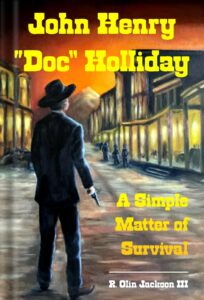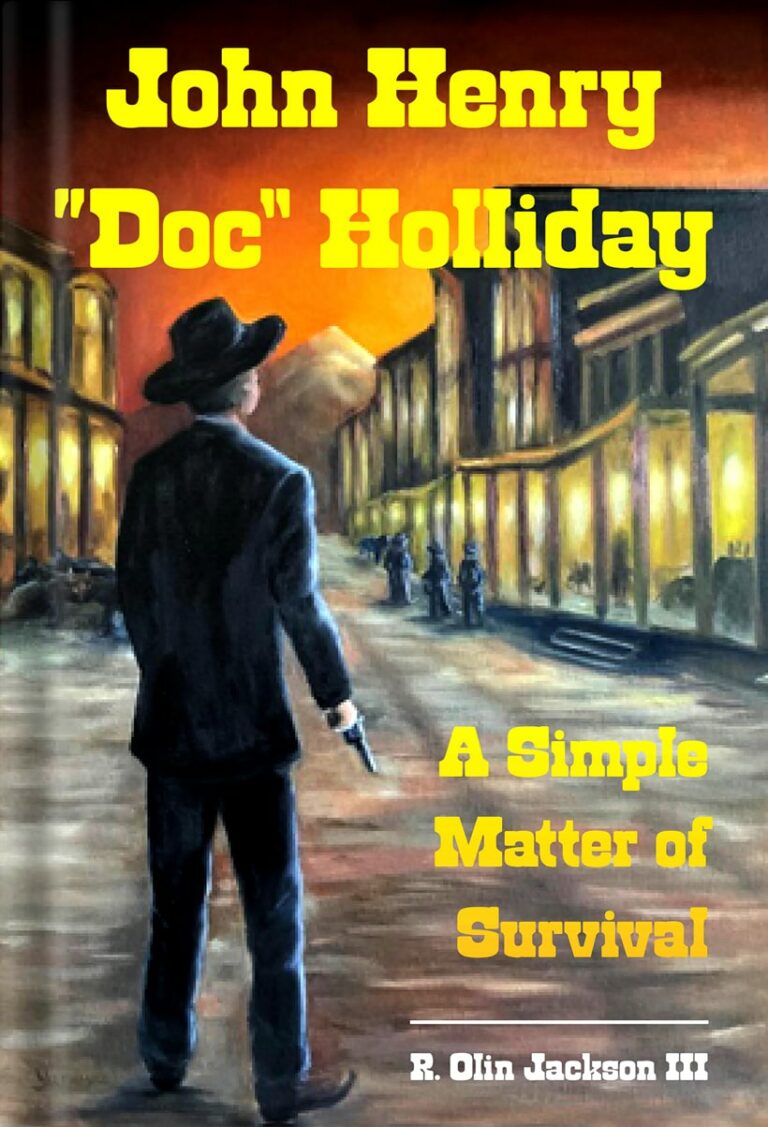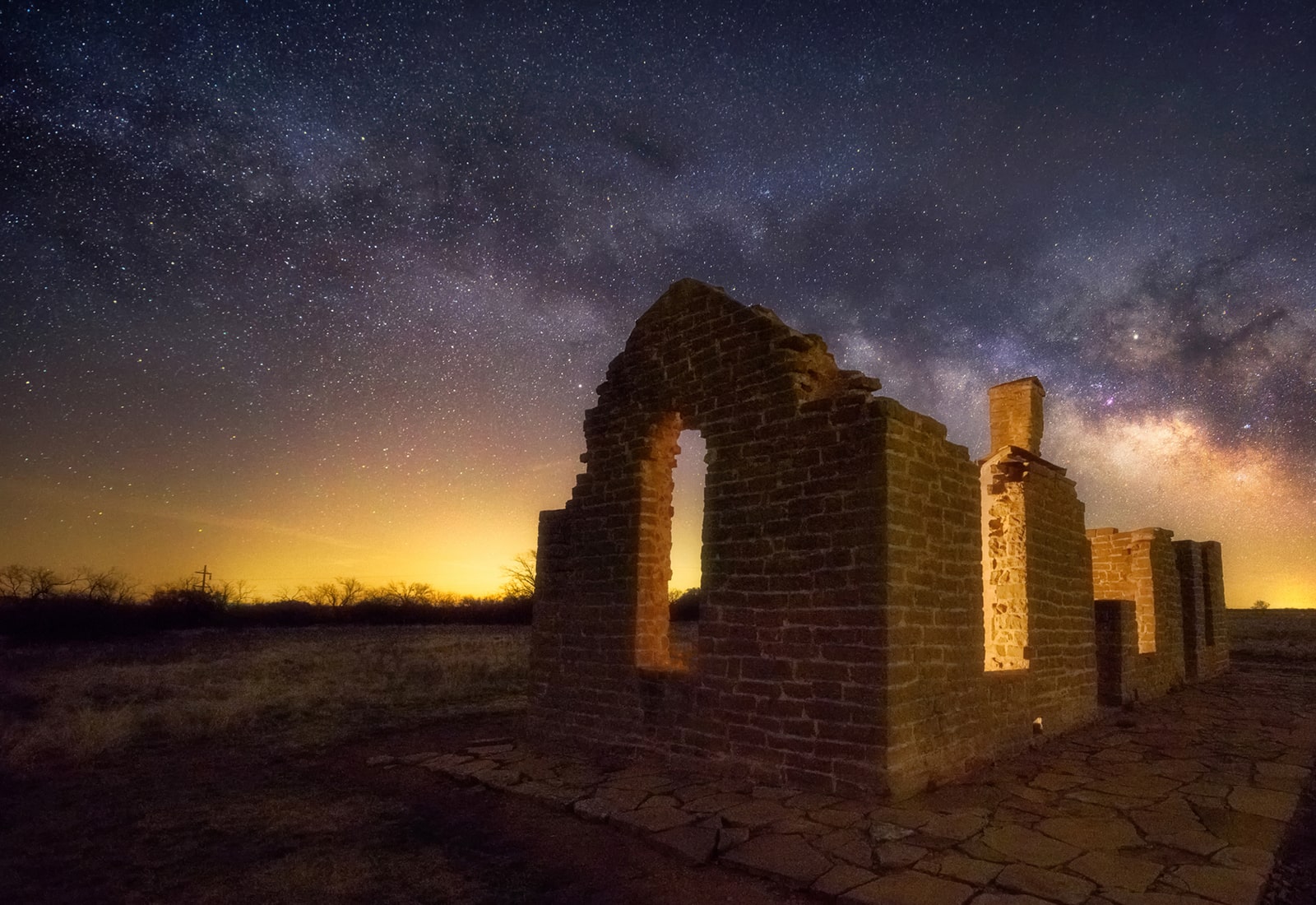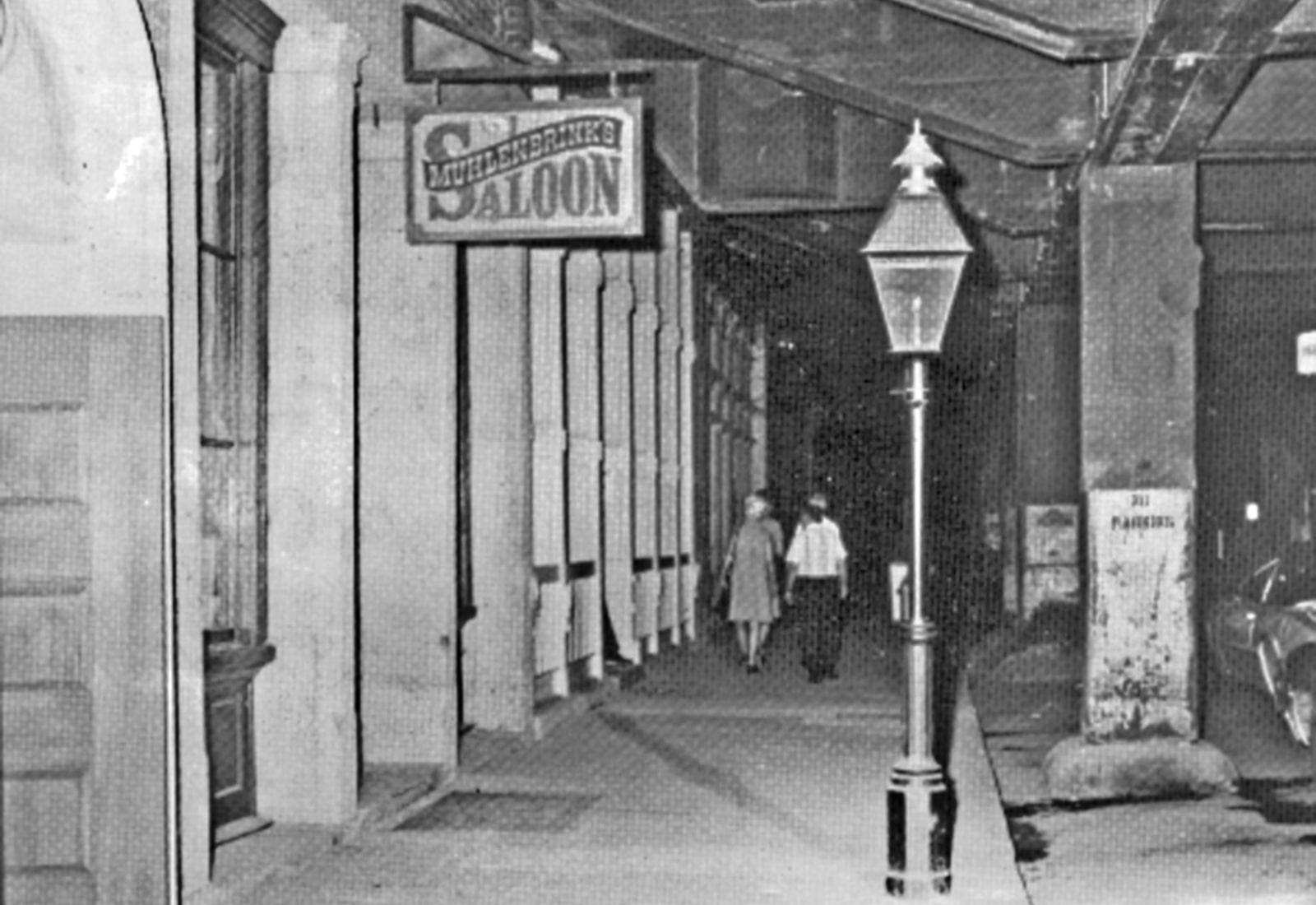He was well-educated, and, early in his life, seemed destined for a long productive career as a dentist. Fate, however, dealt him a different hand, sending him upon a circuitous route through the Old West where he faced many challenges before tuberculosis finally took him.
It was the wildlife and gold in the Rocky Mountains of the West which attracted the early miners and trappers as the last frontier in America was being settled in the 19th century. And with the gold-mining towns came other intrepid adventurers and gamblers such as John Henry Holliday.
Despite the many things that are known about him today, Holliday is, in many ways, an enigma – a mysterious individual. He traveled aimlessly throughout the West in the dying days of the old frontier. He left few writings of his experiences, so there are many gaps in his collective history. Newspaper accounts of that time were notoriously inaccurate and sometimes virtually fictitious, and many of the letters he sent back home to family and friends were later destroyed or lost.
It is known, however, that once out West, Doc had no intention of returning to his Georgia home. Whether this was due to his gambling and widely-reported gunfights, or to his debilitating health, is unknown today.
Despite their beauty, the Rockies in Colorado must have been very taxing for Doc toward the latter portion of the 1880s. His tortured lungs had been seriously impaired by the tuberculosis bacterium eating away within him. He must have been constantly out of breath, often wondering if he was going to make it to the next day. Anyone who has been to the 10-, 11-, and 12,000-foot altitudes in these mountains has experienced this gasping need for oxygen. One can only imagine how it affected an individual as sick as was John Henry Holliday.
By this point, however, the die had been cast. He had little left to live for, and no way to make a living except the gambling trade. His terrible coughing fits had eliminated any possibility of the pursuit of the dental profession for which he had been trained.
He spent a substantial amount of time in Denver from 1882-1884. His last days, however, were spent in the mining towns of Leadville and Glenwood Springs, Colorado.
From Arizona to Colorado
On the way to Denver, Colorado, in the summer of 1882, Doc reportedly had met up with several other old acquaintances in Pueblo: Bat Masterson, Sam Osgood and an individual known only as “Texas George.” According to later reports, the men planned to attend the horse races in Denver and checked into the Windsor Hotel on the northeast corner of Eighteenth and Larimer streets in that city.
The five-floor Windsor was a 300-room hotel – one of Denver’s finest – and with its white marble floors, plush red carpeting and sixty-foot mahogany bar, it was just the type lavish establishment that the gambler from Georgia both admired and enjoyed. Again – the finer things in life always drew his attention.
One must find it at least mildly surprising that Masterson would stoop to socialize with Holliday at all, since it was widely-known that he detested him because of his oft-drunken and abrasive habits. One could also find Masterson’s attitude toward Holliday ironic, since Masterson himself would soon be officially ejected from Denver and told never to return due to his own outrageous drunken behavior.
Unfortunately, Doc’s penchant for trouble caught up with him once again in Denver. An individual by the name of Perry Mallen arrested Holliday on a warrantless and fraudulent murder charge associated with Doc’s days in Arizona Territory. Mallen identified himself as an associate and envoy of Sheriff Johnny Behan of Cochise County in Arizona, where Doc was in fact “Wanted” for his participation in the earlier-referenced “Vendetta Ride.”
As a result, Mallen was able to have Doc jailed in Colorado, but the Georgian ultimately was rescued several weeks later by Bat Masterson, who, as a law enforcement official himself, indicated he was taking Doc into his custody himself for the return to Arizona. Masterson escorted Doc out of town and then set him free. Though he generally found Holliday detestable, he came to the tubercular gambler’s assistance at the request of his friend Wyatt Earp, who had come to his (Bat’s) aid on more than one occasion in the past.
Denver To Leadville
In a continued effort to escape his past, and to maintain his livelihood in gambling, Doc departed Denver and traveled by stage approximately 125 miles southwestward to the town of Leadville in Colorado. This community had been a mining boomtown since 1877 when a rich vein of silver and lead ores had been discovered. By the time Doc arrived in July of 1882, the mining of these metals had slowed, but there were still many gambling opportunities at the scores of saloons and bordellos yet remaining in this former boomtown.
One can only guess today at Holliday’s perception of Leadville back in the 1880s. Did he enjoy the snow, or did he simply find it to be another shivering impediment to life? What was it like in the bleak shadows of the Rockies in a time when there was no indoor plumbing in most establishments, and no warm comfortable automobiles in which to travel about? Granted there were trains to the site. The Denver & Rio Grande had arrived in 1880, and the Colorado Midland arrived in 1887. Doc reportedly made use of them whenever possible, but more often than not, he either traveled on horseback or within the freezing confines of a jarring stagecoach.
When he arrived in the high mountain town, Doc found employment as a faro dealer at Cyrus “Cy” Allen’s Monarch Saloon which was located at 320 Harrison Avenue. (This structure still exists today in this now sparsely-populated town.) However, he didn’t last long there. His illness had caused him to become heavily dependent upon alcohol by this time, and it affected his ability to perform his job. His employment at Allen’s Saloon ended almost as quickly as it had begun.
According to reports, Holliday found new work nearby as a faro dealer in one of the clubrooms of Hyman’s Saloon owned by Mannie Hyman. It was located at 316 Harrison Avenue next door to the Tabor Opera House [both of which also are still in existence as of this writing (2023) in downtown Leadville]. Doc apparently decided this was a good spot to put down some roots. He was able to obtain a room upstairs on the northwest corner of this building. (At last check, this room was still being maintained as a historic memorial to the famous gambler.)
Bleak Existence
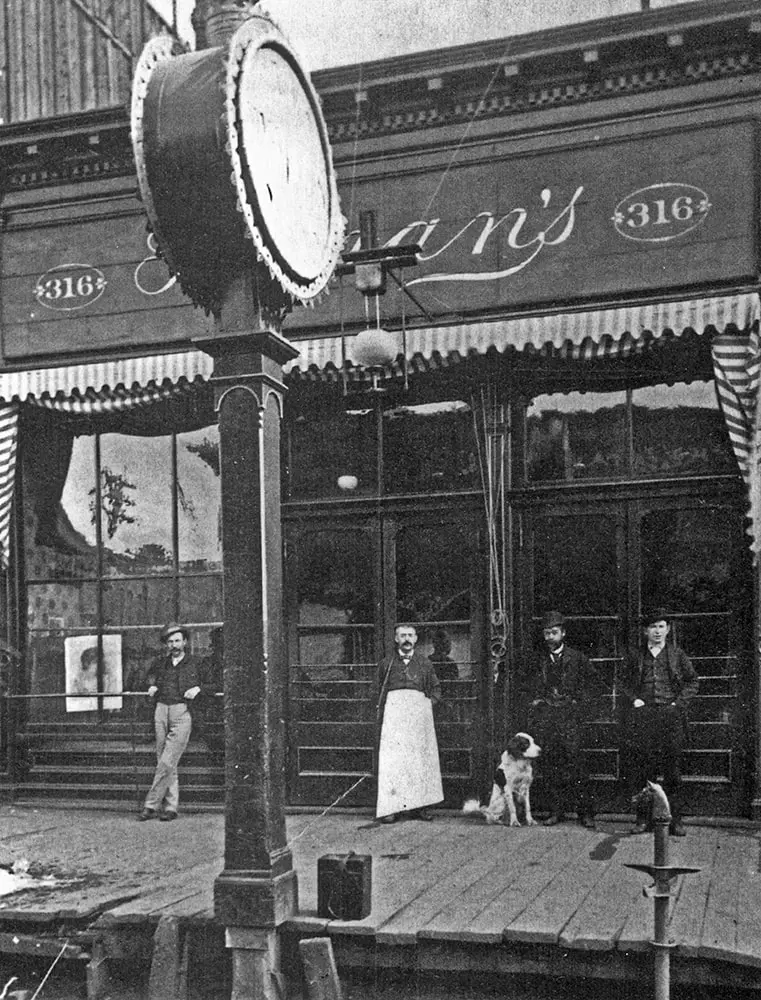
Doc’s tiny room – seven by fourteen feet – was his refuge in these years in Leadville. It gave him a beautiful – albeit bleak no doubt to him – view of the snow-covered Rockies. When he wasn’t sleeping, Doc almost always could be found in Hyman’s saloon, dealing the faro games, or, across the street at John G. Morgan’s Board of Trade Saloon where he often sat on the player’s side of the table, playing stud poker.
According to reports, during the years 1882 to 1886, Doc occasionally visited most of the gambling houses along Harrison Street, plying his trade. However, by this time, his physical condition had severely debilitated his skills as a gambler, and his winnings had declined considerably. He also almost certainly had difficulty finding a table at which to play due to his bad cough. As a result, he was often short of money, and began leaning upon the goodwill of others to survive.
It seems almost pitiful to imagine Doc Holliday by this point in his life. He was very quickly succumbing to the tuberculosis ravaging his lungs and his health in general. He had always been slight in stature, but had been lightning quick with strong hands and arms, and usually capable of handling himself when confronted. His growing alcoholism, however, had affected his diet – and thus his weight and strength. He had also lost most of his stamina due to the tuberculosis in his lungs and to two bouts of pneumonia with which he suffered during this period. In short, Doc Holliday was a pitiful sight by the mid-1880s.
When the whiskey – with which Doc was liberally self-medicating himself – ceased to offer a balm to the pain and destruction of his lungs, the once handsome dentist and gambler reportedly found another medication – laudanum. A local druggist who owned an apothecary at the corner of Sixth and Harrison streets, befriended Holliday and reportedly provided the drug to him.
His growing dependency on laudanum coupled with the severe bouts of pneumonia weakened Holliday even more. He was able to sustain himself with an occasional win at the card tables, but it was a meager existence at best.
Becoming A Target
As a result of his obviously weak physical state, the wolves began circling Holliday. He increasingly became a target for roughneck gamblers and predators in general who sought to earn a name for themselves by becoming the person who out-gunned or defeated the great Doc Holliday.
In his prime, Doc had usually needed only to identify himself to most belligerents – even vicious ones – in order to avoid a fight. However, by the time he reached Leadville, he was so obviously weak and debilitated that he had become an easy mark. More and more, the stronger bullies pushed ever harder to humiliate Holliday and goad him into a fist or gunfight.
Though he was weak and disabled, Doc – to his credit – was never a coward, and he would not be bullied, regardless of the circumstances. For this reason, Leadville, Colorado, enjoys the unique distinction of being the site of John Henry Holliday’s last gunfight.
Two of Doc’s old Tombstone, Arizona, enemies – William “Billy” Allen and Johnny Tyler – unfortunately were living in Leadville at the time of Doc’s residence there. According to Karen Holliday Tanner in Doc Holliday: A Family Portrait, Allen was a former Leadville policeman who had been a friend of Ike Clanton – Doc’s old Tombstone nemesis. Allen had even served as a prosecution witness during the O.K. Corral shooting inquest and had testified against Doc.
“. . . he (Allen) had accompanied Reuben Coleman on the day of the gunfight in Tombstone,” Ms. Tanner writes. “They had walked down Allen Street through the O.K. Corral to the front of Camillus S. Fly’s Gallery (behind Fly’s Boarding House). It was believed by some, and certainly by Doc, that during the fracas, Allen had fired a number of shots aimed at both Holliday and the Earps from the passageway between Fly’s buildings. After coming to Leadville, Allen had been a part-time policeman and had been hired as a bartender at the Monarch Saloon.”
Confronting Johnny Tyler
Ms. Tanner also explains how Johnny Tyler – after the Tombstone years – was dealing faro at the Casino Gambling Hall in Leadville. “Tyler had not forgotten the humiliation he had suffered in 1880 when he was evicted from Tombstone’s Oriental Saloon by Wyatt Earp with Doc looking on, laughing and taunting him,” Ms. Tanner adds. “Tyler harbored tremendous anger and resentment toward Doc and now prepared to vent it.
“Johnny Tyler and Billy Allen plotted their vendetta. . . In August of 1884, Doc found himself in the unenviable position of owing Billy Allen five dollars. Allen, knowing of Doc’s dire straits (financially), had willingly loaned the money, assuming that Doc would have difficulty repaying the debt. This would give Allen justification to goad the weak, sick Holliday into a gunfight. Doc had borrowed the money with the promise to repay it in less than a week. Seven days later, he had to go to Billy and humbly explain that he had not been able to collect an outstanding debt and therefore did not have the money (to repay Allen).”
For a number of weeks in Leadville, Doc was continuously insulted and humiliated by Johnny Tyler and his cohorts. In an earlier day, they would not have dared to confront and challenge him in such a manner, but in 1884, Doc was only a shadow of his former persona, and his antagonizers knew it. They relentlessly taunted him, threatening him with gunplay.
By this time, Doc no longer even carried a gun, having been threatened with jail-time should he be caught with a sidearm. He was virtually destitute, and since he could not afford to pay a fine for possession of a firearm nor survive in the cold dank jails of that day, he had sworn off his weapons entirely. After having been stopped and searched a number of times by the Leadville police, he was very careful not to violate the city ordinance concerning firearms.
“Words passed between him and Tyler and his cronies at Hyman’s Bar, and several of them called him to ‘pull his gun,’” a local Leadville newspaper reporter wrote at the time. “He said he had none, and as he passed outside, he was called filthy names. . . Next day, he told this writer, with tears of rage coming to his eyes as he talked, that they were insulting and humiliating him because they knew he could not retaliate.”
Allen Eats Lead
Billy Allen, who had been waiting for his opportunity, finally issued Doc an ultimatum: Pay the debt owed to him by noon of the following Tuesday or face the threat of severe violence.
“When Tuesday arrived, some of Doc’s friends went to his room and told him that Allen was looking for him with a gun,” Ms. Tanner continued. “. . . . On the stairway down into the saloon, Doc asked Mannie Hyman to get an officer for protection. He continued into the saloon but did not find Allen. He asked his friend and fellow boarder Frank Lomeister, who was working the day shift as bartender, to get Capt. Edmond Bradbury of the Leadville Police Department or Marshal Harvey Faucett, adding that he did not want to sit around for the afternoon unprotected.”
Though death’s angels were closing in upon him, John Henry Holliday continued to fight for life. According to reports of this famous incident, he returned to his room where he remained in the tiny enclosure until approximately five o’clock in the afternoon. He knew, however, that he eventually would have to go back down to the saloon to work, but he also knew that he would have to defend himself if he did, and that he couldn’t afford the fine nor a prison term if he was caught with a firearm.
Totally desperate by this point, Doc instructed one of his friends to take his (Doc’s) Colt’s .41 revolver down and hide it behind the bar. He then went down to the saloon himself and sat near the end of the bar behind the cigar case where he could quickly grab his gun if necessary.
It was obviously a very dramatic setting, one more characteristic of Doc’s earlier days perhaps in Dodge City or Tombstone. According to reports of the incident, Billy Allen eventually did enter the saloon, and he had the misfortune to have his hand in his pocket as if holding a weapon.
When Doc saw Allen’s hand in his gun pocket, that posture created Doc’s alibi to defend himself. Without hesitation – and in a flashback to the days when he fearlessly defended himself – Doc Holliday immediately grabbed his handgun and quickly fired a round at Allen. The bullet found its mark, striking the unfortunate victim in the fleshy part of his upper arm and severing an artery.
When Allen fell to the floor in pain, Doc fired at him yet again. He meant to legally end this threat once and for all, because he knew if he did not, Allen would be back to try yet again. This second round struck the door sill, barely missing Allen’s head. Even with his severe debilitation, Doc was still a deadly-accurate gunman if necessary.
Before he could get off another shot, however, Doc was grabbed from behind by Henry Kellerman who wrestled the gun away. This action almost certainly saved Billy Allen’s miserable life, and also possibly saved Doc from being charged with first degree murder.
Doc, nevertheless, was subsequently arrested by the Leadville marshal and charged with “Assault with intent to commit murder.” He was locked up in jail and his bail reportedly was set at $5,000.00 – both circumstances were exactly what the gambler had feared. In 1883, the sum of $5,000.00 was the equivalent of well over $150,000.00 in 2023 dollars.
Interestingly, in an earlier day and time, John Henry Holliday might possibly have raised that amount to bail himself out of jail, but by the time of his days in Leadville, the ex-dentist – as explained above – was living virtually hand-to-mouth. For that reason, $5,000.00 was an impossibly high bail for him to raise, and he must surely have thought he was going to be incarcerated in a freezing-cold and damp jail for months until his trial date arrived.
On Trial for Assault
Interestingly, though it has seldom been publicized, Doc – despite his oft-abrasive personality – seemed to consistently cultivate a coterie of close friends willing to help him when necessary. Two of these stepped forward immediately. John G. Morgan and Samuel Houston, co-owners of the Board of Trade Saloon (which also still exists today in Leadville as of this writing in 2023) arrived the next morning and immediately posted bail for Doc.
In the trial that followed, a number of eye-witnesses testified to the threats that had been issued at Doc by Allen, and the circumstances of the shooting that had followed. Doc took the stand on his own behalf and explained the details of the loan and the subsequent threats.
“I saw Allen coming in with his hand in his pocket, and I thought my life was as good to me as his was to him,” Holliday explained in his courtroom testimony. I fired the shot and he fell on the floor, and (I) fired the second shot; I knew that I would be a child in his hands if he got hold of me; I weigh 122 pounds; I think Allen weighs 170; I have had pneumonia three or four times. I don’t think I would have been able to protect myself against him.”
The jury ultimately returned a verdict of “Not Guilty” in the case of People vs John Henry Holliday. Following this last gunfight, the curtain essentially came down on the public life of John Henry Holliday, ending his gun-fighting days forever. He was never again involved in a shooting incident.
Not too long after the trial, Doc, for good reason, no doubt felt the urge to move on to another town. He first took a short trip back to Denver one last time before returning briefly to Leadville.
Holliday had learned of a town called Glenwood Springs, Colorado, which had a variety of steamy sulfur water grottos outside town, and of the fact that some individuals had gone there for the treatment of various health problems. This town, no doubt, was doubly attractive, since it was not only known as a health resort, but also as a mining town too, with many saloons and other gaming establishments which offered Doc yet another opportunity to ply the gambling trade. It offered just the opportunity he sought at this point in his life.
Last Days In Glenwood
Today, Glenwood Springs isn’t much larger than it was in Doc’s day in 1887. (It might even be smaller.) The warm springs are still active and frequented by many individuals interested in the presumed curative qualities of the waters.
Doc once again found himself on a cold, bumpy, and exceedingly uncomfortable stagecoach headed farther up into the Colorado Rockies. He made the trip from Leadville to Glenwood Springs in May of 1887. [The railroad (Denver & Rio Grande) did not reach Glenwood Springs until October 5, 1887, so it was unavailable as a travel medium for Doc’s trip.]
By 1887, Doc’s appearance reportedly was that of an individual well-advanced in years, with silver hair and an emaciated stooped posture. According to a news article of that day, “He walked down the street with a feeble tread and a downcast look. If he heard a (gun)shot, he raised his head with eager attention and glanced this way and that.” Even in 1887, Glenwood Springs obviously was still somewhat wild and unsettled.
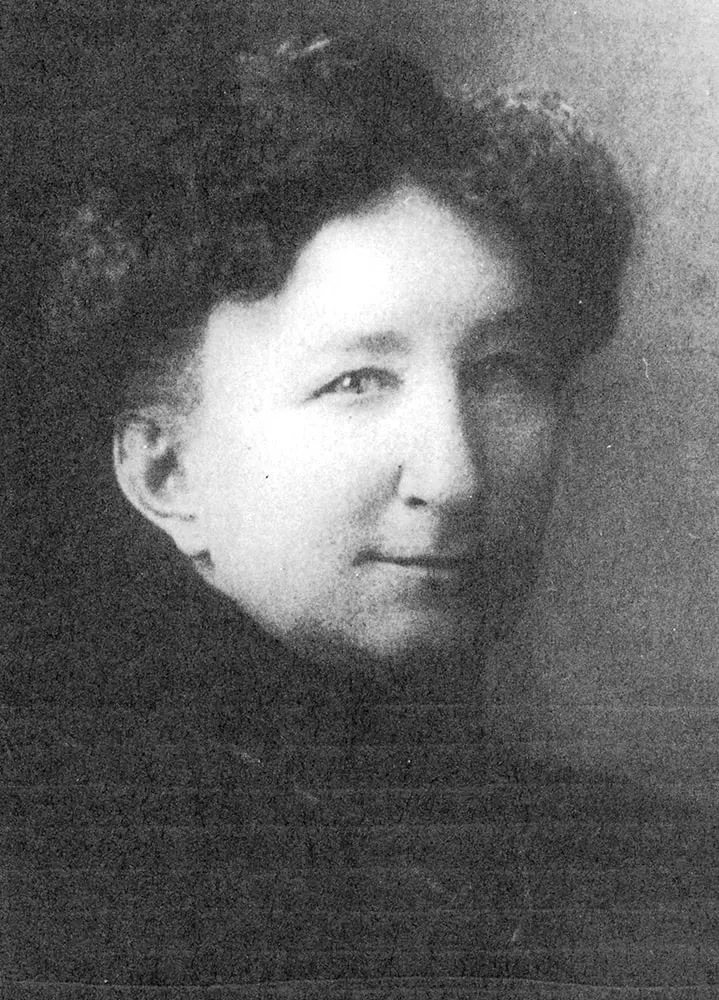
He fully intended – and did – take advantage of the sulfur springs in a never-ending quest to stem the tide of the destructive bacteria in his lungs. Ironically, rather than curing Doc’s ills, the acidic and acrid vapors caused even more damage to his already-ruined system. His cough quickly worsened, and his health declined even more rapidly.
Just as had been the case in both Denver and Leadville, Doc reportedly was admired and welcomed by a number of individuals, and quickly cultivated a coterie of friends in Glenwood Springs in the weeks immediately following his arrival.
After his arrival, he reportedly attempted once again to ply his old trade at the gambling tables. By this point, however, he simply no longer had the stamina to participate. Gone was the vitality which had served him so well in Kansas and Arizona and earlier in Colorado. With the departure of his strength also went his will to live. He no doubt knew his last days truly were upon him at this point.
His spirits understandably were low, and, according to Karen Holliday Tanner, Doc had written to his former consort – Mary Katherine “Big-Nose Kate” Harony in Globe, Arizona – telling her he was traveling to Glenwood Springs, and asking her to join him there. By this point, Doc must have known he was fast approaching the time when he would need someone to physically assist him with the rudimentary tasks of daily life. He no doubt knew of no one to call upon except Kate, and she, to her credit, responded admirably.
Doc and Kate had traveled many miles together earlier in their lives. They had enjoyed many adventures across the West in places like Las Vegas, New Mexico; Dodge City, Kansas; Tucson and Tombstone, Arizona. This bond no doubt held them together as Doc fought for life in the final months of his life.
In Kate’s Care
Many accounts today indicate Doc died alone and abandoned in the Hotel Glenwood in his last days. One recently-discovered (2004) and very credibly-documented record (explained in detail in the following chapter) however, indicates an entirely different scenario.
Whatever the circumstances, Doc took a room at the Hotel Glenwood on the northeast corner of Grand Avenue and Eighth Street in Glenwood Springs. This exceptional hotel had just recently been built (1886), and was among the finest in the West at that time. It offered among its amenities electric lights, both hot and cold running water in every room, and even flush-toilets. The water was pumped directly from the Grand (later renamed Colorado) River, since there was no water system in the town, with the sewage being returned directly into the river downstream.
Most of the old saloons and gambling establishments in Glenwood Springs are gone today, replaced by more modern structures. The Hotel Glenwood burned to the ground on December 14, 1945, killing five people, and destroying forever the final home of John Henry Holliday.
Though the town fathers of Glenwood Springs seem to have paid limited heed toward historic preservation over the years, the community yet retains a scenic air, unique with its warm springs. The stark Rockies are still startlingly beautiful, but they must have been cold and forbidding to Doc in his dying days.
During the last 57 days of his life, John Henry Holliday reportedly rose from his bed at the Hotel Glenwood only twice. He and Kate reportedly relied upon the bellhop to serve them their meals so that Kate did not have to leave his bedside.
It is poignant to imagine Kate attending to him in these last hours. She easily could have ignored his request to join him in Colorado, knowing the task of caring for him during this time would not be pleasant. She reportedly never wavered from her duties however, and even used her meager savings to support them after Doc could no longer work. In her later years, she said she considered her relationship with Doc to be a marriage.
All the years of smoking, drinking, poor diet and poor care finally caught up with the famed gambler. Pneumonia and tuberculosis ultimately combined to do what many gunmen over the years had failed to accomplish. By the third week in October of 1887, Doc was delirious, and by Monday of November 7, he reportedly was unable to speak, so many researchers and writers maintain it is unlikely he ever uttered the now-famous last words, “This is funny,” as claimed in folklore. He died on November 8, 1887.
Kate’s Last Days
Interestingly, Doc’s consort for all those years in Arizona and Colorado – Mary Katherine Horony – reportedly gathered up Doc’s belongings from his room after his death, and shipped them to Doc’s one true love – his cousin, Sister Mary Melanie of the Order of the Sisters of Mercy – who had entered a convent to become a nun after Doc left Atlanta, Georgia for the West.
After she had disposed of Doc’s last possessions, Kate then left the sadness in Glenwood Springs forever, but reportedly remained for a time at her brother’s home nearby in the Crystal Valley region of Colorado. On March 2, 1890, she married George M. Cummings in the mining town of Aspen, Colorado, a well-known ski resort today. The couple moved about the West before finally settling in Bisbee, Cochise County, Arizona, in 1895, just a few miles from Tombstone where Doc had gained so much fame in 1881-1882.
This marriage lasted approximately nine years before Kate left Mr. Cummings who was an alcoholic. (Katherine Harony enjoyed little if any luck in her selection of men.) On June 2, 1900, she accepted employment as the housekeeper of John J. Howard of Dos Cabezas, Arizona. She remained in his employ until Howard’s death in 1930. On June 13, 1931, Kate wrote to Arizona Governor George W. Hunt requesting permission to live in the state-supported Arizona Pioneers Home in Prescott.
Governor Hunt reportedly granted Kate’s request. For the last nine years of her life, Mary Katherine Cummings (nee Horony) – also known in history as “Big-Nose Kate” – lived out her final days in the town where, in 1880, she and Doc had spent time together just prior to his Tombstone days. She died on November 2, 1940, and was buried at the Pioneer Cemetery in Prescott.
Today, one can only imagine how John Henry Holliday felt in his last days, separated from his family and friends back in Georgia, as well as his surrogate family – the Earps – who, by that time, were scattered from Arizona to California. Thankfully, he did have Kate in his last days. She no doubt brought him comfort in his final hours.
It, however, seems a pity the last remains of one of the most famous and fabled of all the individuals of the old West, lie in an unknown and unmarked grave today, mysterious and yet respected even in death. Ironically, that’s probably just the way Doc would have wanted it. His lonely wandering soul is finally at peace.
